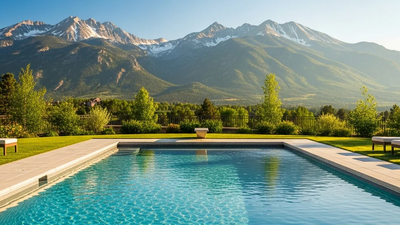
As an Idaho pool owner, you're facing unprecedented challenges that extend far beyond typical seasonal maintenance. Our state's changing climate, combined with documented water quality issues and increasing natural disaster risks, creates a perfect storm of pool maintenance headaches that traditional cleaning methods simply can't handle.
The Idaho Pool Owner's Perfect Storm
Living in Idaho means dealing with environmental factors that make pool maintenance uniquely challenging. According to the University of Idaho's McClure Center , our state is experiencing significant climate changes characterized by rising temperatures that affect everything from water resources to wildfire patterns. These changes directly impact your pool's cleanliness, safety, and maintenance requirements.
Experience from the Field: Real Idaho Pool Owner Challenges
After helping thousands of Idaho pool owners tackle these issues, we've identified the most critical problems you're likely facing:
Water Quality Contamination : Idaho's groundwater contains naturally occurring arsenic, with concentrations highest in southwestern counties like Gem and Owyhee, as well as Kootenai County and Jefferson County ( Idaho DEQ ). In Coeur d'Alene specifically, arsenic levels in the Hanley Well exceeded EPA standards at 26.2 ppb in 2023 ( City of Coeur d'Alene ).
Phosphorus Problems in the Treasure Valley : If you're filling your pool with Boise area water, you're introducing phosphorus from the Lower Boise River system, which receives runoff from agricultural and urban areas through tributaries like Indian Creek and Mason Creek ( Idaho DEQ Lower Boise River Analysis ).
Understanding Idaho's Unique Environmental Threats
Climate-Driven Challenges
Idaho's warming climate creates a cascade of pool maintenance issues. Warmer and drier conditions are extending wildfire seasons, posing greater threats to communities and severely impacting air quality ( University of Idaho McClure Center ). This means your pool is exposed to ash and debris contamination for longer periods each year.
The state's infrastructure faces increased stress from extreme weather events, including heatwaves that accelerate water evaporation and create ideal conditions for algae growth ( Idaho Infrastructure Report ).
Natural Disaster Vulnerability
Ada County, home to Boise and the state's largest population center, faces the highest disaster risk assessment in Idaho. The county's emergency management identifies dam failure, earthquakes, floods, cold waves, and heatwaves as significant hazards ( Ada County Risk Assessment ).
Expert Solutions: Advanced Pool Maintenance for Idaho Conditions
Step 1: Address Source Water Contamination
The Problem : Arsenic and phosphorus contamination in your fill water creates ongoing water balance issues and potential health concerns.
The Solution :
- Test your source water before filling
- Install pre-filtration systems for initial fills
- Implement more frequent water testing protocols
- Use professional-grade robotic cleaning systems to maintain water quality without frequent drainage
Why Robotic Cleaning Matters : Traditional skimming and manual cleaning can't keep pace with Idaho's contamination levels. The iGarden K60 Pool Cleaner provides the consistent, thorough cleaning needed to manage contaminated source water, with its AI scheduling system automatically adapting to your pool's specific contamination patterns.
Step 2: Combat Wildfire Ash and Debris
The Problem : Extended wildfire seasons deposit ash and fine particulates that traditional filtration systems struggle to handle.


The Expert Solution :
During wildfire events, ash contamination can overwhelm standard pool cleaning methods. The iGarden K Pro Pool Cleaner addresses this challenge with its Turbo 200% enhancement mode, specifically designed to tackle stubborn ash residue that settles on pool surfaces and becomes embedded in traditional cleaning systems.
Advanced Cleaning Protocol :
- Deploy robotic cleaners immediately after ash events
- Run extended cleaning cycles (the K Pro's 15-hour runtime handles the most severe contamination)
- Use intelligent navigation to focus on problem areas where ash typically accumulates
- Maintain consistent cleaning schedules even during extended wildfire seasons
Step 3: Manage Extreme Temperature Fluctuations
The Problem : Ada County's documented high risks from both heatwaves and cold waves create rapid chemical imbalances and accelerated contamination cycles.
The Solution :
Temperature extremes require adaptive cleaning strategies. The TurboX Master Pool Cleaner excels in these conditions with its advanced intelligent cleaning capabilities that adjust intensity based on detected contamination levels, ensuring optimal performance regardless of weather extremes.
Step 4: Seasonal Maintenance for Idaho's Harsh Conditions
Spring Preparation :
- Inspect for winter freeze damage (critical in Idaho's climate)
- Test and address source water contamination immediately
- Deploy AI-scheduled cleaning to establish baseline cleanliness
Summer Intensive Care :
- Increase robotic cleaning frequency during wildfire season
- Monitor for algae growth accelerated by warming waters
- Maintain consistent cleaning during water shortage periods to avoid frequent refills
Fall and Winter Protection :
- Prepare for Ada County's identified cold wave risks
- Ensure proper winterization to prevent freeze damage
- Schedule periodic cleaning during milder winter periods to prevent contamination buildup
Cost-Effective Maintenance in Idaho's Challenging Environment
Traditional pool services in Boise average around $125 monthly, but Idaho's unique environmental challenges often require additional emergency cleaning services that can double these costs. DIY maintenance typically runs $300-800 annually in chemicals alone, but doesn't address the sophisticated cleaning needs created by our state's environmental conditions.
The ROI of Advanced Robotic Cleaning :
Investing in professional-grade robotic cleaning technology like the iGarden K Series provides:
- Reduced chemical costs through better water circulation and debris removal
- Decreased need for emergency cleaning services after environmental events
- Extended pool equipment life through consistent maintenance
- Water conservation through reduced need for complete water changes
Frequently Asked Questions
Q: How do I know if my fill water contains arsenic or phosphorus?
A: Contact your water utility for recent testing reports, or have your water independently tested. In areas with documented contamination (southwestern counties, Kootenai County, Jefferson County, and the Treasure Valley), assume contamination is present and plan accordingly.
Q: Can robotic pool cleaners handle wildfire ash effectively?
A: Yes, but only advanced models with sufficient suction power and intelligent navigation. The iGarden K Pro's Turbo mode and extended runtime are specifically effective for ash contamination that overwhelms standard cleaners.
Q: Should I drain my pool after major wildfire events?
A: Not necessarily. Proper robotic cleaning can often restore water quality without complete drainage, which is especially important during Idaho's documented water shortage periods.
Q: How often should I run robotic cleaning during wildfire season?
A: During active wildfire periods, daily cleaning cycles may be necessary. The iGarden K Series' AI scheduling adapts automatically to contamination levels, optimizing cleaning frequency.
Protecting Your Investment in Idaho's Changing Climate
Idaho's environmental challenges aren't decreasing. With climate change extending wildfire seasons, increasing extreme weather events, and ongoing water quality issues, pool owners need sophisticated solutions that traditional maintenance methods can't provide.
The combination of documented environmental threats—from Ada County's multiple disaster risks to statewide water quality concerns—requires proactive, technology-driven maintenance strategies. Advanced robotic cleaning systems offer the consistent, adaptive cleaning power needed to maintain safe, enjoyable pools despite Idaho's challenging conditions.
By understanding these unique environmental factors and implementing appropriate cleaning technologies, Idaho pool owners can protect their investment while ensuring safe, clean water for their families throughout our increasingly challenging environmental conditions.
This guide is based on official data from the University of Idaho McClure Center, Idaho Department of Environmental Quality, Ada County Emergency Management, and the Idaho Office of Emergency Management. For the latest environmental updates affecting your area, consult these official sources regularly.








